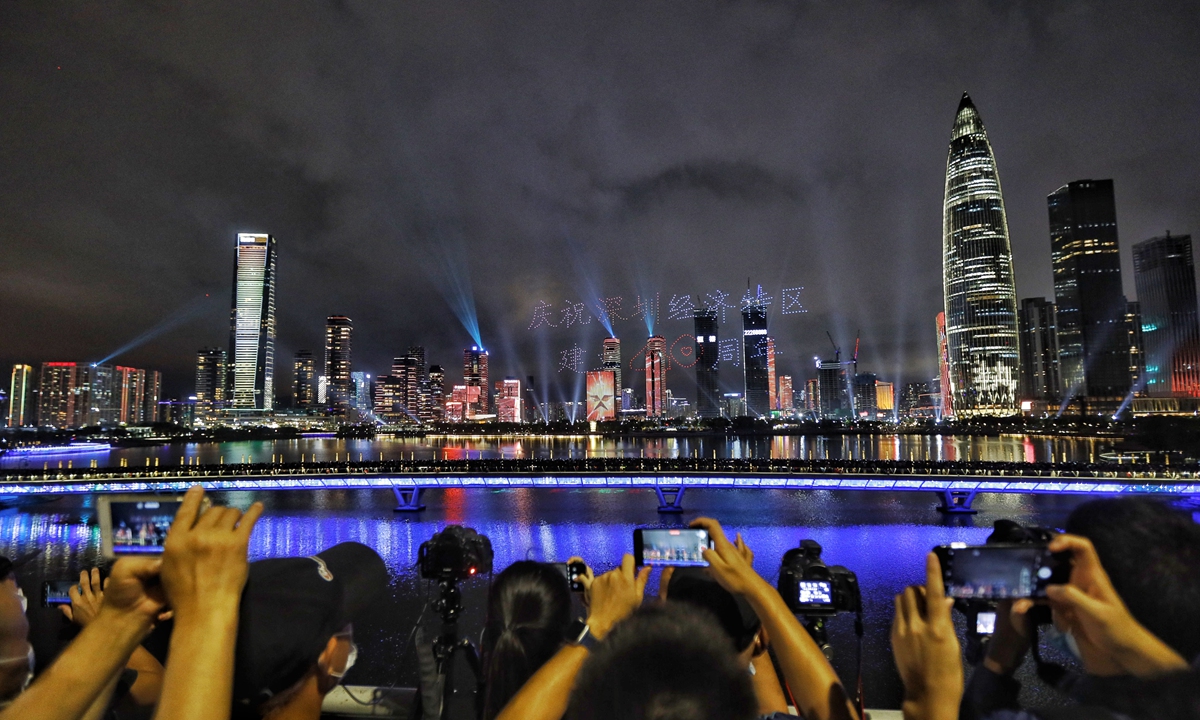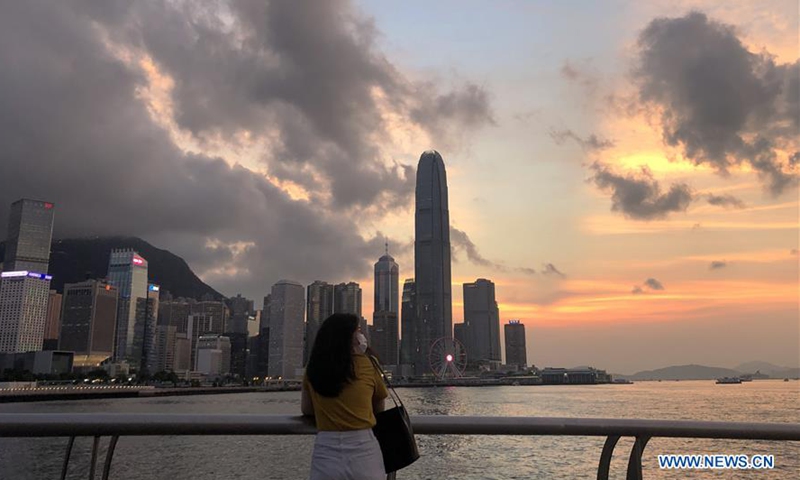A tale of two Chinese cities
By Chen Qingqing and Li Xuanmin in Shenzhen Source: Global Times Published: 2020/8/26 22:03:41 Last Updated: 2020/8/26 21:58:32
Forty years on, a fresh start for Shenzhen, Hong Kong

Forty years ago, when some local villagers in Shenzhen, which was then composed of deserted farmlands, looked beyond the river, they often imagined a different lifestyle: the hustle and bustle of a metropolis, eagerness to learn and create new things, charming celebrities who shape the entertainment culture of Hong Kong, a neighboring city with free market values.
Since then, the two neighboring cities have become a microcosm of the country's spectacular change, within which Shenzhen, as China's first special economic zone (SEZ), accomplished an economic miracle. From learning from Hong Kong to catching up with the special administrative region (SAR), Shenzhen sometimes displays numerous skyscraper light shows at night, which has become brighter than the illuminated Victoria Harbor.
When it comes to the relationship between China's first SEZ, which aims to become a pioneering demonstration zone for socialism, and Hong Kong - a city which serves as the bridge between the country and the Western world - cross-boundary residents who frequently travel between the two sides have many words to define it.
Before the coronavirus outbreak, early morning every day, cross-boundary students lined up in front of border control points at Futian or Luohu. Numerous containers carrying fresh vegetables, fruits and meat passed through land ports, providing daily necessities to Hong Kong residents.
As what HKSAR government chief secretary Matthew Cheung Kin-chung said in a recent interview about the relationship between Shenzhen and Hong Kong, "Hong Kong cannot survive without Shenzhen."
Over the past 40 years of China's economic reform and opening-up, the roles of the two cities have always been complimentary, supporting each other and jointly exploiting more opportunities in the Greater Bay Area, Cheung said.
However, when Hong Kong experienced months-long anti-government protests in 2019, which dragged the once prosperous Asian financial hub into recession, more voices emerged over whether the central government would grant more favorable policies to Shenzhen, its neighboring city, and even replace the crisis-stricken Hong Kong with a model city representing China's speed and ambition.
Especially when Shenzhen celebrated the 40th anniversary of the establishment of the SEZ, those voices sparked heated debate about the roles the two cities could play, and the future paths the two cities could take.
Rise of Shenzhen
Li Pui, a Hong Kong businessman who started his own company in Shenzhen three years ago, had just completed the strict quarantine procedures in Shenzhen, which enabled him to get back to work at a robot industrial park in Shenzhen's Baoan district.
Due to the resurgence in COVID-19 cases, some of his colleagues and business partners, who are from Hong Kong, could not return to Shenzhen in time.
"I see more Hongkongers wanting to do business in Shenzhen since last year, or in the Greater Bay Area. Take a look at what young people here, like those in their early 20s, talk about everyday: How to start a new business, how to integrate into a new industry… they are often preoccupied by those thoughts," Li, who is also the chairman of the Guangdong-Hong Kong-Macao Greater Bay Area Youth Society, told the Global Times on Tuesday.
"That's not the case in Hong Kong," he remarked.
While more and more Hong Kong entrepreneurs like Li are obsessed with face scans for mobile payments, ultra-fast 5G coverage, service robots that deliver food and beverage to their doorsteps in Shenzhen, some still remember the 1980s when Shenzhen began to undertake reforms, introduce a no-nonsense approach, and embrace the outside world. At that time, those who took part in this transformation looked up to their friends and business partners in Hong Kong, who offered help in capital, technology, talent and fresh mind-sets.
Some business representatives also attributed Shenzhen's rise to its proximity to Hong Kong.
"Prior to 2012, Shenzhen benefited from investment from Hong Kong businessmen, as well as foreign capital into the mainland via Hong Kong. It learned modern corporate governance, and financial products and services from their Hong Kong peers," an employee surnamed Hai at a Hong Kong financial institution, who frequently travels to Shenzhen, told the Global Times on Wednesday.
Kris Tsang, a 30-something Hongkonger, could still recall the time he arrived in Shenzhen for the first time in the 1990s.
"It was a totally different view from the bustling Hong Kong. Shenzhen was messy and obsolete. There was no subway, and we had to travel by taxi and bus, which was very inconvenient," Tsang recalled.
But the rapid development of Shenzhen over the past decades has surprised and impressed Tsang. Lured by the city's vibrant atmosphere and innovative spirit, Tsang, as well as thousands of like-minded Hong Kong youths, decided to start a career there, benefitting from Shenzhen's new round of reform and opening-up.

A citizen wearing mask is seen on the shore of the Victoria Harbor in Hong Kong, south China, Aug. 24, 2020. Photo: Xinhua
Complimentary roles
The proximity and growth prospects of the two cities help them complement each other, as they see growing business activities, capital flow, and people-to-people ties in recent years.
For example, to date, in Shezhen's Qianhai district, 12,000 Hong Kong companies have set up business units there, Cheung was quoted as saying in media reports. Also, over 27,100 Hong Kong students who live in Shenzhen and study in Hong Kong need to travel across everyday.
"Shenzhen and Hong Kong have their own charm, and not about replacing one with the other. It's more like a brotherhood, standing with each other and offering help when needed," Wanda Jiang, a Hong Kong businessman, told the Global Times on Wednesday.
The 49-year-old businessman, who spends two days in Hong Kong and five in Shenzhen every week in the wine business, values the role of Hong Kong as an international trading hub, which has more favorable tariff policies and mature sales channels.
"What Shenzhen needs is to continue to attract talent from Hong Kong, enabling more Hong Kong young people to experience the fast growth of the mainland, and have a deeper understanding of the country's future," he said, noting that such understanding will also help regional integration.
When the Heung Yuen Wai-Liantang port, a new land port between Hong Kong and Shenzhen, was officially opened on Wednesday, HKSAR government chief executive Carrie Lam hailed the border crossing put into operation at the 40th anniversary celebration of the establishment of the Shenzhen SEZ. The seventh land-based control point could further foster a "one-hour living circle" of Hong Kong and the Greater Bay Area.
For some Hongkongers eager to integrate into the bigger plan of China's development, the recently enacted national security law for Hong Kong signals a fresh restart, both for Hong Kong and its neighboring city, by restoring peace and order. The two neighbors are also expected to continue supporting each other in a more concrete and dynamic way.
"The 'reborn' Hong Kong could better play its role in helping Shenzhen companies expand their global footprint. Hong Kong's advanced research and development, plus Shenzhen's amazing speed in translating theoretical foundation into application, is also a perfect combination," Tsang said.
Posted in: HK/MACAO/TAIWAN